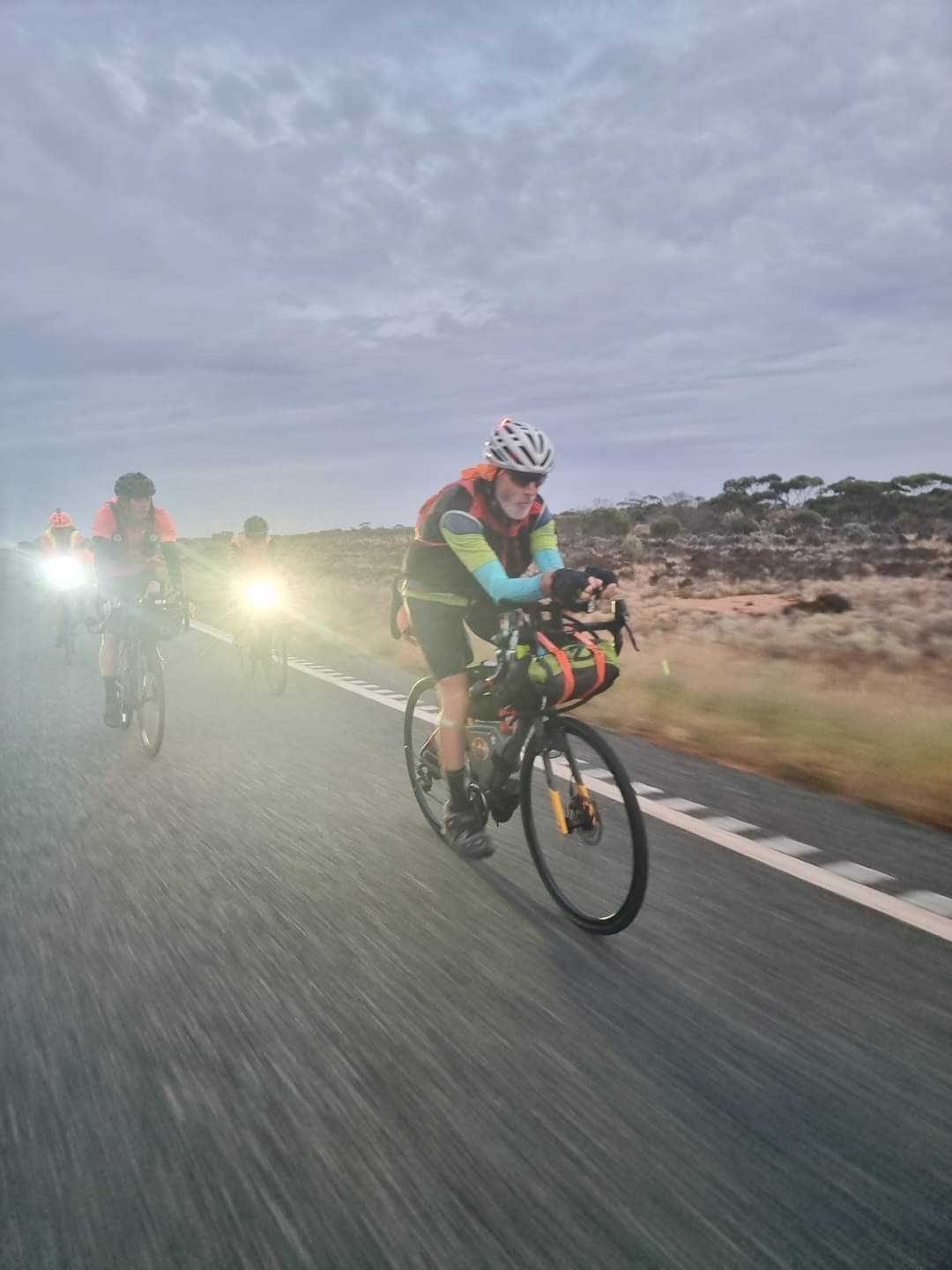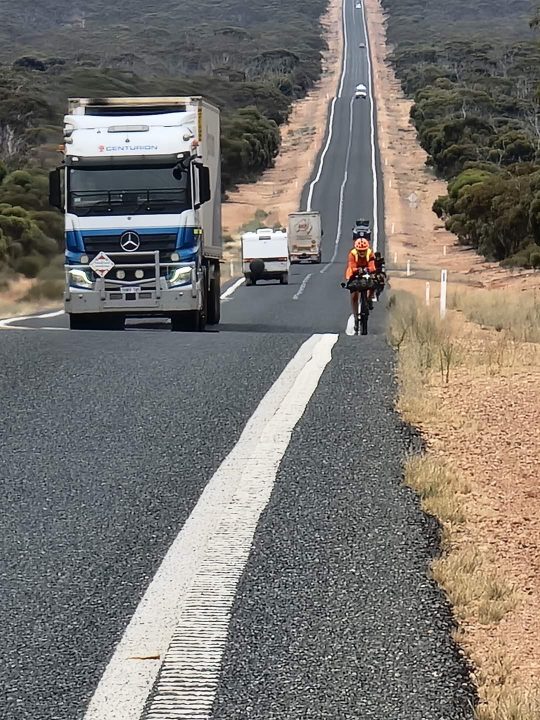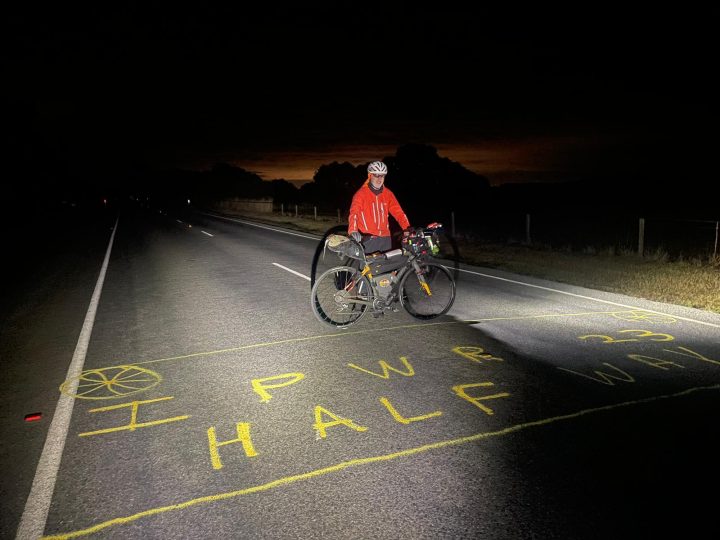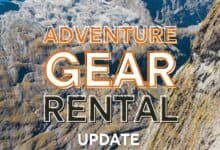
Having ticked off the Kennett trio (Tour Aotearoa, Sounds to Sound and Kopiko) Geoff Harris was looking for a new challenge. He wanted to extend his range both physically and mentally so when he hit upon the Australian Indipac endurance cycling event, he knew he’d discovered his next adventure. The event begins with a wheel dip in the Indian Ocean in Perth and finishes with a wheel dip in the Pacific Ocean at the Sydney Opera House.
The Indian Pacific Wheel Race is the brainchild of ultra-endurance racer, Jesse Carlsson. Impressed by the intrepid adventures of very early Australian cyclists, he wanted to both celebrate their achievements and open opportunities to present-day adventurers. Carlsson had several defining principles in the creation of the race. Cycling across a country (and continent!) is always a significant achievement and both Perth and Sydney offer airports for international participants. He wanted the race to be entirely on sealed roads and to traverse Australia’s beautiful and varied countryside, including desert, the Great Ocean Road, rolling hills and snowy mountains. The course passes through the state capitals of Adelaide, Melbourne and Canberra not only to provide further entry/exit points for tourers but also to provide an urban contrast to the rural settings. Mindful of traffic, Carlsson set much of the course on cycle tracks and back roads through these busy centres.

The Indipac is advertised as a self-supported, solitary, single stage endurance race and it has had an unsettled, brief history. The inaugural race was held in 2017 but it was cut short when Mike Hall, worldclass cyclist and a leading contender, was struck by a vehicle outside Canberra. His dot marked the moment, stopped at 6.22am. The race was immediately cancelled. The following year the organisers cancelled the race five weeks out because of the ongoing inquest. However, cyclists were already committed so there was an unofficial departure at 6.22am on the set day, the Indipac quietly morphing from an official race into a memorial event. In 2020 it was again called off partway through when states began closing borders because of covid. This also terminated hopes for 2021 but in 2022, it was back on with 16 participants and Geoff became an avid dot watcher. Seduced by the romance of biking through the Nullarbor (Latin: no trees) Desert, he was one of the first to sign up for 2023.
The 2023 briefing two nights before the event was a relaxed affair at South Mall Beach, Freemantle where the 25 participants were given few but vital pieces of information. Essentially, they were on their own, with accommodation and supplies their own responsibility. They were advised to wear high vis at all times, and they were notified of a few detours and road closures. It seemed scant on details for such a momentous journey, but Geoff realised that it would be, as always with bike-packing, an adventure that would have to be taken on a day-to-day basis.
Dawn 16 March was a chilly and nervous time. Geoff had slept little the night before and as he lined up with other riders at the South Mole Lighthouse for the 6.22am start, Sydney looked a universe away. Was he crazy?
The sendoff, however, was enough to lift the most trepidatious of spirits. Dozens of Perth riders turned out to escort the Indipac riders on their way and the first day was a lovely but very long ride with headwinds all the way. These 30km winds blew for the next few days, providing Geoff with his first reality check as he was unable to stick to the plan he’d optimistically drawn up in New Zealand. By the second day his riding pace had aligned with that of Matt, Captain Stever and several other riders. They were a mixed bunch. Matt, at 19, was the youngest participant while Captain Steve was a veteran Indipac rider. As a group, they decided to quit early that day, get some sleep, then rise at midnight when it would be cooler, the road trains far fewer and with less chance of headwinds. Their lights would also be more visible. Despite sleep being plagued by motel mice and bedbugs, the plan worked, and they maintained this regime for the Nullarbor and other tricky stages.
And so it was that the ‘grupetto’ (Geoff, Matt, Captain Steve, Shelley, Rhys and Grumpy) formed. Geoff used the term self-deprecatingly, but it was picked up by cyclists and dotwatchers alike, though the spelling morphed into groupetto, which was perhaps a more accurate description. It was by no means exclusive – other riders joined in at different stages of the event and were missed when they left. While the groupetto didn’t always ride together, they generally set out at the same time, headed for the same destination. This had several advantages. As well as being congenial, there was backup if needed with repairs and advice, as well as cost savings with shared accommodation. Experiences were shared which led to more informed decision making.
Of course, the riders had stretched out enormously, with the leaders already over 200km ahead by the second night and this distance extended each day. These driven, extremely tough and experienced cyclists would go on to experience a high dropout rate as fatigue and injuries took their toll. Mattussio set a blistering lead with over 400km a day for the first few days, which then dropped into the 300s, then into the 200s. On day 7, he withdrew when his neck could no longer support his head. Saddle sores were a scourge. One rider, unable to bear sitting, stood on her pedals instead and thus did her knees in. But, of course, there were other injuries such as torn calf muscles, a hernia, upset stomachs.

During the first few days, Geoff was adjusting to Australia and Australians and they to him. As the only Kiwi, Geoff came in for a fair amount of ribbing. “Go on, say ‘deck’,” they’d urge. Once he asked if anyone had booked cabins. “Kevins?” his companions asked mystified, then fell about laughing when they realised what he was saying. He in turn learned new terms: servos (garage cafes), dongas (sleepouts) and pluggers (jandals).
The countryside was gloriously different, and it was fun to see kangaroo loping along. It was less fun to see them splattered on the roadside – a chilly reminder of how vulnerable cyclists are in the face of road trains. These trucks are seriously nerve wracking. Over 50m long and weighing up to 200 tonnes, they bowl along at (officially) 90 km/h and, from Coolgardie on, they became a constant presence. Geoff was relieved to have his Garmin varia radar, but he was glad too that he often rode with Captain Steve who had a two-way radio and could chat to the truckers. There was only one rule here; cyclists must get out of the way. When the road was empty, trucks gave cyclists a wide berth, but on a rise, curve or with oncoming traffic the cyclist had to move. This could be a smooth transition into the hard packed dirt or a sudden 20cm drop into marble size gravel. 30mm tires or bigger are essential for this event.
On Day 6, Geoff began his favourite section of the event, the Nullarbor (1250 km long) where drinkable water supplies are 160 – 200 kilometres apart. In previous years, cyclists contended with 40°C, blazing sun and burning headwinds. The groupetto’s night rides were helpful but they were also lucky as headwinds abated and temperatures remained below 30°C. It even drizzled at times. Geoff had long dreamed of the desert and now revelled in the huge flat spaces, dead straight roads, spartan roadhouses and sparse vegetation. In these moments, he would ring his bell to be mindful of the special privilege of being in this place at this time and the groupetto began sharing the moment too. Sunrises were spectacular and nothing could beat the anticipation for a flat white and huge breakfast at the first servo open after dawn.
Accommodation proved scarce. One night, six of them slept in a laundry. Another time they lined up along a deck of a very busy pub, sleeping through the revellers’ din. Geoff began formulating a list of handy attributes for Indipac cyclists. Foremost is the ability to go to sleep at 6pm – no matter the location – to wake at 1:00am. Coming from New Zealand, he had an advantage as he was on Kiwi time so these early risings weren’t quite so brutal, but the groupetto did land up being extremely sleep deprived. Being able to poo on demand before heading out was undeniably more advantageous than being caught out in the inky blackness of the Aussie bush and its attendant dangers of snakes and spiders. A rider also cannot have too many lights: front lights, rear lights and helmet lights are essential. Reflective tape on seat stays, forks, helmets, cranks and even the backs of shoes is also advisable.

It was in the Nullarbor that Geoff’s rear wheel developed a pronounced wobble. Bike shop mechanics in Melrose diagnosed a terminal crack in the rim with the nearest replacement in Adelaide, still 450km away. There was little he could do but cross his fingers and enjoy the ride which was always entertaining. They encountered a venomous Big Brown snake on the highway and he cuddled a baby wallaby in a pub. When they came to the border between WA and SA, there was a quarantine station where all fruit and vegetables had to be declared. “Keep quiet,” Captain Steve advised. “Don’t let them know you’re a Kiwi!”
Coming out of the Nullarbor into Ceduna on Day 11 was an assault on all senses. The servo was teeming, music blared, and the huge variety of food staggered. As the groupetto made its way past Port Augusta, the road trains fell away and supply options became more frequent. The landscape softened into rolling green hills and wonderful trail angels appeared with food, drink and good cheer. Local cyclists and dotwatchers also turned out to meet them and this continued for the rest of the event. Reaching Adelaide was a relief and Geoff finally bought a new wheel. However, this necessitated changing to a smaller cassette which reduced the climbing ratio from 48/48 to 42/42. He had strong misgivings this would not be sufficient for the huge mountain passes ahead and the 800 metre climb out of Adelaide gave him an uncomfortable taste of what was to come.
The Great Ocean Road was a spectacular leg but coming into Melbourne was a nightmare of traffic lights and signs. The groupetto was in danger of getting lost when fortunately local guides unexpectedly swung in front and took over navigation for the day. Among these guides was Cedrych who had begun the event in Perth but had been forced to pull out on the second day because of a vicious stomach bug. Having recovered, he decided to join the groupetto for the second half of the event, so he led them through Melbourne to his penthouse apartment for a night of luxury.
Geoff had some serious decisions to make. He had spent the previous day mentally writing his “resignation post” for the Indipac dotwatchers site, resolved to fly home from Melbourne. But now he thought, “May as well go on to Canberra.” Problem was, having focused all his attention on the Nullarbor, he realised he was woefully underprepared for coming mountains and snow. A quick trip to the ski shop secured a woolly hat, warm gloves and overshoes. He also cut up his survival blanket to wrap around his core and add an extra layer under his overshoes. He was still worried about his climbing gears but this was not the time for doubts.

A few days later the reformed groupetto (by this time, Geoff, Matt, Captain Steve, Cedrych and Ian and it would stay this way to the finish) were up at 3am to tackle Mount Hoffman (1,861 m). It was bitterly cold. Snow heaped beside the road. Dawn brought light but no relief to the freezing conditions. Geoff caught up with Matt at a refuge toilet where hand-driers resuscitated frozen fingers – though it took a good five minutes to do so. It was here that Geoff learned to keep his gloves inside his cycling shirt to keep them warm. By this stage he was desperate for that holy grail of bikepacking – the morning flat white. He was relieved, therefore, to learn from a passing local that the Mt Hoffman store was only 8km away. Very soon they were plunged into an alternate universe, where they sat beneath chairlifts, blissfully scoffing toasted cheese sandwiches and coffee while watching children make snowballs.
The 30km switchback descent was nerve-wracking. Geoff’s front brakes screamed all the way down as the groupetto dropped from the snowy peak into temperatures in the early 20s. More surreal still was the sight of cyclists on the lower slopes going up the road for their Saturday morning ride.
The next challenge was Kosciuszko National Park, (3800m of ascent over 140kms), which presented a post-apaclypic landscape of burnt-out forests, still not recovered from the terrifying 2020 fires. Unrelenting rain set in. It was a case of just gritting teeth and grinding onward, upward. When the gradient went over 18 percent, Geoff walked. The previous 2000km were taking their toll and he knew that, more than ever, the event was a psychological challenge. He was also dismayed to find there was no water resupply. Although there was a lot of water around, it all looked dodgy; water, water everywhere and not a drop to drink. At one point, cycling alone, he began to doubt he was even on the right road. Suddenly, astonishingly, a four-wheeled drive pulled over and the driver shouted, “Geoff!” Justine, dotwatcher and trail angel, was on her way to rescue another injured cyclist. She gave Geoff directions to her house, assuring him that the rest of the groupetto were staying with her. Justine set the gold standard as a trail angel providing a warm house, mattresses, a washing machine, mountains of pasta and a lovely family. She was even up at 4am to give them toast and coffee to send them on their way.
Riding along the Monaro Highway to Canberra, Geoff found the traffic insane. It was on this stretch that Mike Hall was killed and the groupetto stopped at his memorial: a ghostly white bike mounted on a fence. It was sobering to think of all the dangers Mike had already survived over the 5000km, only to die so close to the finish, and it heavily brought home their own fragility.
After Canberra, the route follows the A48 – hours of cycling through night-time, nightmare, extremely impatient traffic. The shoulder was a mere 20 cm and there was glass and detritus everywhere. Geoff had not been expecting this and, with the aura of Mike Hall still following him, this road was particularly nerve-wracking. He was profoundly relieved when he finally made it to Wollongong. Suddenly, there were only 127km left to go which was just as well as Geoff’s bike was in a sad state. His front brake pads were missing; he’d decided against replacing them as he still had the back ones. The stretched chain should have been replaced weeks earlier and both tyres were dangerously worn. The future shock on his Specialized Diverge could now only be described as a past shock. When he gave the bike a gentle shake, he could hear the broken bits rattle. Still, not far to go.
The final day was perfect weatherwise, and the scenery through the National Park was a treat. Many cyclists were out for their weekend rides and coffee was easily found. Coming into Sydney itself proved challenging. A direct route to the Opera House would have been too easy! The course took them along what felt like every cycle trail in Sydney, through endless traffic lights, around road closures and detours. The Garmin reroutes added to the confusion but finally – blessedly – they arrived at the Harbour Bridge and could see the Opera House on the far side. Once over the bridge, the route was still confusing, but Geoff felt as long as they kept the sun on their left shoulders, they’d get there. A few hundred metres from the Opera House the groupetto fanned out, taking the whole lane. At the familiar cry of “car back”, Geoff yelled that it could bloody well stay back!

Then suddenly they were there coming up on the Opera House and, ignoring the No Cyclists sign, they rode in side by side towards a small, loudly cheering crowd of family, friends and dotwatchers. Geoff’s wife was having an operation so could not be there but special friend Kath flew down from Brisbane as a surprise. He was delighted to see a splendidly familiar and most unexpected face. Of course, there were the triumphant photos on the steps of the Opera House, There were introductions, hugs and handshakes, lots of laughter, and it was all over. The groupetto peeled away in different directions. The Indipac, for them, was finished.
Geoff returned to New Zealand the following day, very sleep-deprived and five kilogrammes lighter. For a week he ate like the hungry caterpillar, emptying pantry, fridge and freezer. If he lay down for just a minute, he’d fall asleep. But a few weeks later, both he and his bike were restored, and he immediately began looking for the next challenge….
SIDE BAR: Bike and gear
2019 Specialised Diverge Expert
Brooks B17 Saddle
Aerobars with 75mm risers
4.5 litre Crank Tank + 2 x 750ml bottles
30mm GP 5000 tires
2X 1000 + lumens headlights + Varia rear light and backup
Gamin 1030plus with Topo Maps on phone for navigation
Tent, sleeping bag and mat
Didn’t have but should’ve – A very large flat mirror!
Budget – Approximately $1 per kilometre plus flights








